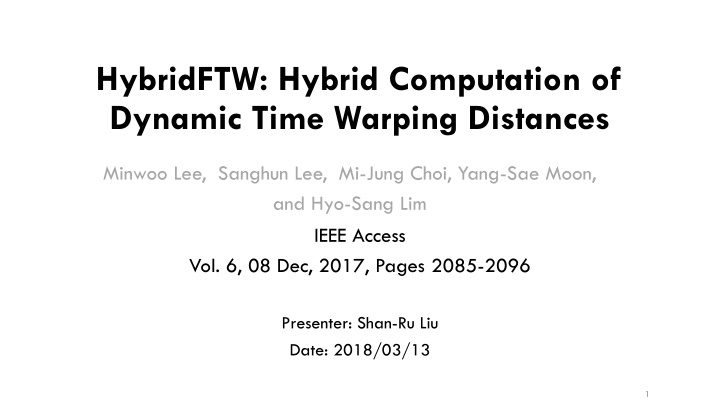
Hybrid Computation of Dynamic Time Warping Distances
HybridFTW proposes an efficient approach combining FastDTW and FTW methods to compute Dynamic Time Warping (DTW) distances in time-series similarity search. By leveraging dynamic bands and lower bounding functions, HybridFTW significantly improves search performance compared to existing methods.
Download Presentation

Please find below an Image/Link to download the presentation.
The content on the website is provided AS IS for your information and personal use only. It may not be sold, licensed, or shared on other websites without obtaining consent from the author. If you encounter any issues during the download, it is possible that the publisher has removed the file from their server.
You are allowed to download the files provided on this website for personal or commercial use, subject to the condition that they are used lawfully. All files are the property of their respective owners.
The content on the website is provided AS IS for your information and personal use only. It may not be sold, licensed, or shared on other websites without obtaining consent from the author.
E N D
Presentation Transcript
HybridFTW: Hybrid Computation of Dynamic Time Warping Distances Minwoo Lee, Sanghun Lee, Mi-Jung Choi, Yang-Sae Moon, and Hyo-Sang Lim IEEE Access Vol. 6, 08 Dec, 2017, Pages 2085-2096 Presenter: Shan-Ru Liu Date: 2018/03/13 1
Abstract (1/2) In this paper, we propose an efficient approach that computes the dynamic time warping (DTW) distance in time-series similarity search. The DTW distance is known to offer the high accuracy in similarity search, but it has difficulty in supporting the large database due to its high computational complexity. Recently, FastDTW and FTW have been proposed for efficient computation of DTW distances, but they have still performance limitations. In this paper, we propose a hybrid approach, called HybridFTW, which combines the advantages of both FastDTW and FTW. First, HybridFTW takes the advantage of FastDTW that provides fast computation through the limitation of allowable ranges. 2
Abstract (2/2) We call these allowable ranges dynamic (warping) bands, which reduce the computation spaces on the fly, and we reanalyze previous FastDTW and FTW in the viewpoint of static and dynamic bands. Second, HybridFTW also takes the advantage of FTW that exploits the early abandon effect by using the segment-based tight lower bound. To maximize the synergy of combining two methods, we obtain the dynamic band of FastDTW during the process of computing the lower bound in FTW. Using HybridFTW, we next propose range search and k -NN search algorithms and prove their correctness through formal theorems. Experimental results on real and synthetic data sets show that HybridFTW improves the search performance by up to 38 times over FastDTW and by up to 12 times over FTW. 3
DTW ?(? 1,?) ?(?,? 1) ?(? 1,? 1) ? ?,? = ???? ?,? + ??? Time Complexity : O(N2) 4
Speeding up DTW 1) Constraints Limit the number of cells that are evaluated in the cost matrix. Sakoe-Chuba Band Itakura Parallelogram Width = 5 2) Data Abstraction Perform DTW on a reduced representation of the data. 3) Indexing Use lower bounding functions to reduce the number of times DTW must be run during time series classification or clustering. 5
FastDTW (1/2) 1) Coarsening Shrink a time series into a smaller time series that represents the same curve as accurately as possible with fewer data points. 2) Projection Find a minimum-distance warp path at a lower resolution, and use that warp path as an initial guess for a higher resolution s minimum- distance warp path. 3) Refinement Refine the warp path projected from a lower resolution through local adjustments of the warp path. 6
FastDTW (2/2) Radius = 1 FastDTW is not always to find an optimal warp path. However, the path found is usually very close to optimal. The larger the value of the radius parameter, the more accurate the warp path will be. Time Complexity : O(N) 7
FTW (1/3) 1) LBS (Lower Bounding distance measure with Segmentation) 8
FTW (2/3) 2) EarlyStopping 9
FTW (3/3) 3) Refinement Indexing + kNN Search Algorithm 10
HybridFTW (1/4) 1) Hybrid-Stopping Tolerance = 30 12
HybridFTW (2/4) 2) Hybrid-Projection 13
HybridFTW (3/4) 3) Hybrid-Refinement 14
